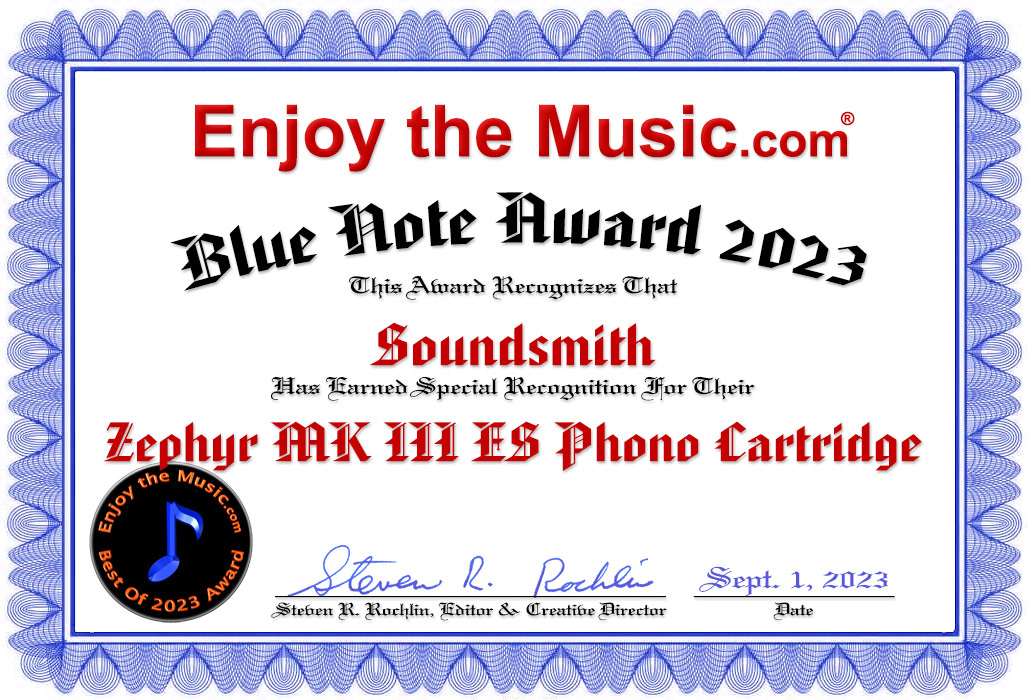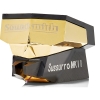SoundSmith Paua Cartridge

"If I had to live with just one cartridge, I would choose the Paua, because it offers more with a wider range of the recordings in my collection. As it stands, the cartridge will be happily employed spinning records in the future, as we have added it to our reference fleet."
- Jeff Dorgay, TONE
Two years ago, TONE awarded SoundSmith our Analog Product of the Year award for its cartridge aptly named The Voice, a moving iron design that retails for just under $2,200. Everyone who had a chance to audition it in our reference system was astonished by its ability to deliver such a high level of performance for such a reasonable price. After 15 minutes of listening, some of the most experienced audio enthusiasts expressed surprise at the cost, expecting it to be higher.
Well, déjà vu is setting in. In a day where $20,000 phono cartridges exist and $10,000 cartridges are relatively common, the Sussurro Paua is priced at $3,495. Every unit is hand-built and optimized by SoundSmith owner Peter Ledermann. It’s a low-compliance cartridge and works equally well in both my SME V and Rega RB1000 tonearms.
While most audiophiles tout the superiority of moving coil cartridges, the Sussurro Paua’s moving iron design allows the stationary magnet in the cartridge to be held rigidly in place, with only the cantilever moving. This results in a much lower moving mass—hugely contributing to the cartridge’s incredible transient attack.
Sussurro or Paua?
SoundSmith’s website reveals two cartridges, the Sussurro and the Sussurro Paua. The former is pricier, at $4,495. Which one is right for you? Both have relatively similar specs. But where the Paua uses a nude contact line diamond, bonded with SoundSmith’s “secure mount” technique to a dual mode aluminum alloy cantilever, the Sussurro features a single – crystal ruby cantilever/stylus assembly. The latter design results in even higher trackability (the Paua is no slouch in this area) and the ability to extract even more information from the grooves.
Chris Sommovigo, SoundSmith’s director of sales and marketing, calls the Paua “a bit more sultry.” I agree. These very characteristics appealed to my built-in bias of liking my system ever so slightly on the warm side of neutral. Not warm, syrupy, and lush; that tends to be slow and lacking detail. Yet, just like my favorite shade of yellow: A color that isn’t 100 % yellow, but 100% yellow with about 3% of red mixed in. I’m talking just the tiniest bit of warmth.
Set-up Basics
(Manufacturer's comment - The below loading comments were for the early design - the current Paua design is engineered for 470 Ohms, with some liking it at 1000 Ohms if they need to accentuate the top end of their system)
The Sussurro Paua differs from The Voice in a few ways. Instead of having standard 47k loading, it works in a range of 1,000–4,000 ohms. For best results, SoundSmith suggests that loading not go above 5,000 ohms. I found 2800 ohms to be optimum, but those only having a 1000-ohm option on their preamplifier should not shy away from the cartridge. Ledermann feels 1000 ohms is the tipping point, “below 1000 ohms tends to lower the HF response and above 1000 ohms tends to accentuate it.” Breaking it in with 1000-ohm loading while waiting for custom-loading resistors to arrive from Audio Research didn’t give me hives. And I could have easily lived with the Sussurro Paua loaded thusly if custom loading was not an option. And as Ledermann mentioned, it does depend on the recording, so I’m glad I have both at my disposal.
While most moving iron cartridges have a fairly high output (in the 2mv range), the Sussurro Paua is unique in the sense that it is a low-output design: .3mv. Again, fewer windings on the coils help reduce the mass and add to signal purity. As an added bonus, the cartridge features a six sided sheilding system, resulting in very low background noise. The Sussurro Paua is definitely one of the most quiet phono cartridges I’ve had the privilege of using.
If you’ve ever had the chance to meet SoundSmith president Peter Ledermann at a hi-fi show, you know he’s a major analog braniac. He’s kind of like Yoda, always thinking of ways to make the whole system better. His new EZ-Mount system (patent pending) features four sets of thumbscrews, made from different materials (nylon, aluminum, stainless, and brass) that vary in weight from one gram per pair to a little more than six grams per pair. Such options allow you to dial in just the right amount of mass at the end of your tonearm. And, as Ledermann mentions on the company’s website: “Now it only takes two hands to mount a cartridge.” No, it’s not as stylish as a pair of small Allen Head screws, but it’s an excellent solution to a vexing problem.
Once you utilize the EZ-Mount system, you’ll happily forgo fashion. Sommovigo mentions that the Paua “is a bit more forgiving in the setup than the Sussurro.” While I am unable to comment on the direct comparison, the Paua is indeed a snap to set up. I can’t imagine this cartridge proving tough for even those with moderate analog skills— especially in the case of an SME user, where the adjustment protocol is so straightforward. Since VTA on the Rega P1000 arm can only be roughly adjusted with spacers, I suggest starting with a 2mm spacer that can be purchased at a local Rega dealer or online from Music Direct.
Tracking force is listed at 1.8 to 2.2 grams, and while starting squarely in the middle of the range worked well, the SME arm tended to navigate the toughest portions of my favorite test tracks at 1.95 grams. The RB 1000 also responded to tracking very close to the 2.2-gram limit. All tracking force measurements were made with the ClearAudio Weight Watcher digital scale.
Nailing the Fundamentals
The Sussurro Paua handled all of the basics with ease. Spot on tonality? Check. Acoustic instruments possessed a perfect balance of tone, attack, and detail. When listening to Miles Davis’ Kind of Blue, or for that matter, any favorite Miles albums, his trademark horn took on a truly three-dimensional feel, with an extra measure of texture that will fool you if you close your eyes for even a few seconds. It’s here where that drop of warmth works to your advantage. I spun a handful of cursory piano and violin records that again reinforced just how natural the Paua sounds. Once you put 20 or 30 hours on the Paua and double-checked the setup, perhaps with a slight bit of readjustment, I recommend trying a few of your standby acoustic tracks.
The excellent musical texture extends to the frequency extremes as well. Staying in the Miles/John Coltrane groove proved a divine experience. The 200g Classic Records pressing of Kind of Blue rendered the cymbal decay without any steps in the gentle gradation; the music just seemed to disappear into the black. Acoustic bass was perfectly rendered, with a thickness of tone that made the instrument absolutely convincing. Standing in the other room, the sound was as close to real as I could imagine. Bass? Neither over- nor under-damped. And the midrange came as close to ideal as you’re going to get unless you start seriously thinking about spending five figures.
Most importantly, the Paua is a fantastic tracker. I couldn’t throw anything at it that it couldn’t handle, and the cartridge sailed through tracks that have given a few more “pedigreed” cartridges a hard time.
Finding the Scooby Snacks
You know a component is great when you revisit old favorites in your collection and they seem new again. The Sussurro Paua makes this happen. Listening to the 200g reissue of Led Zeppelin’s IV, I went straight for “Stairway to Heaven.” While the patron at Wayne Campbell’s local music store would highly frown upon my opinion, I’m so sick of this overplayed song that the Paua would really need to unearth fresh sonic treasures to make me change my mind about ever hearing it again. But that’s exactly what the cartridge did. Robert Plant’s voice never possessed more delicacy, and the revelation forced me to reexamine the entire Zep catalog. Jumping back to the opening track of Led Zeppelin II, “Whole Lotta Love” exploded, yielding a greater contrast between Plant’s quiet, ethereal screams and John Bonham’s propulsive beats during the psychedelic drum solo than I’d ever experienced.
Sometimes you have to go where the music leads you. As much fun as it is exploring new releases with the Paua, I kept getting dragged back to the warhorses in order to hear the differences, digging for tidbits of new details in old favorites that I’d missed before. No matter what path I took, I was always rewarded with a Scooby Snack—an extra helping of Jimi Hendrix’ distortion; a smidge more shimmer in Shelley Manne’s drumming; more cowbell on “Don’t Fear the Reaper.” The Paua continually impressed. This cartridge invites long listening sessions. I always find resolution intoxicating, but never at the expense of smoothness.
One for You, One for Me
The Paua is the ying to my Koetsu’s yang. On recordings that are slightly harsh or flat, the Koetsu Urushi’s extra help of warmth goes a long way in making such LPs more enjoyable, and occasionally, you just want to cheat and get more saturation in the mix. But for recordings at the top of the food chain, the Paua is the go-to cartridge. If I had to live with just one cartridge, I would choose the Paua, because it offers more with a wider range of the recordings in my collection. As it stands, the cartridge will be happily employed spinning records in the future, as we have added it to our reference fleet.
My time spent with the SoundSmith Paua has been grand. Ledermann has created a true analog masterpiece—no small feat given the price. While the Paua is by no means a “budget” cartridge, it certainly has me thinking about the two $10,000 phono cartridges (the Lyra Olympos and the Clearaudio Goldfinger) and wondering if they really need to stay there. Regardless of your system’s performance level, the Paua is worthy. -Jeff Dorgay









